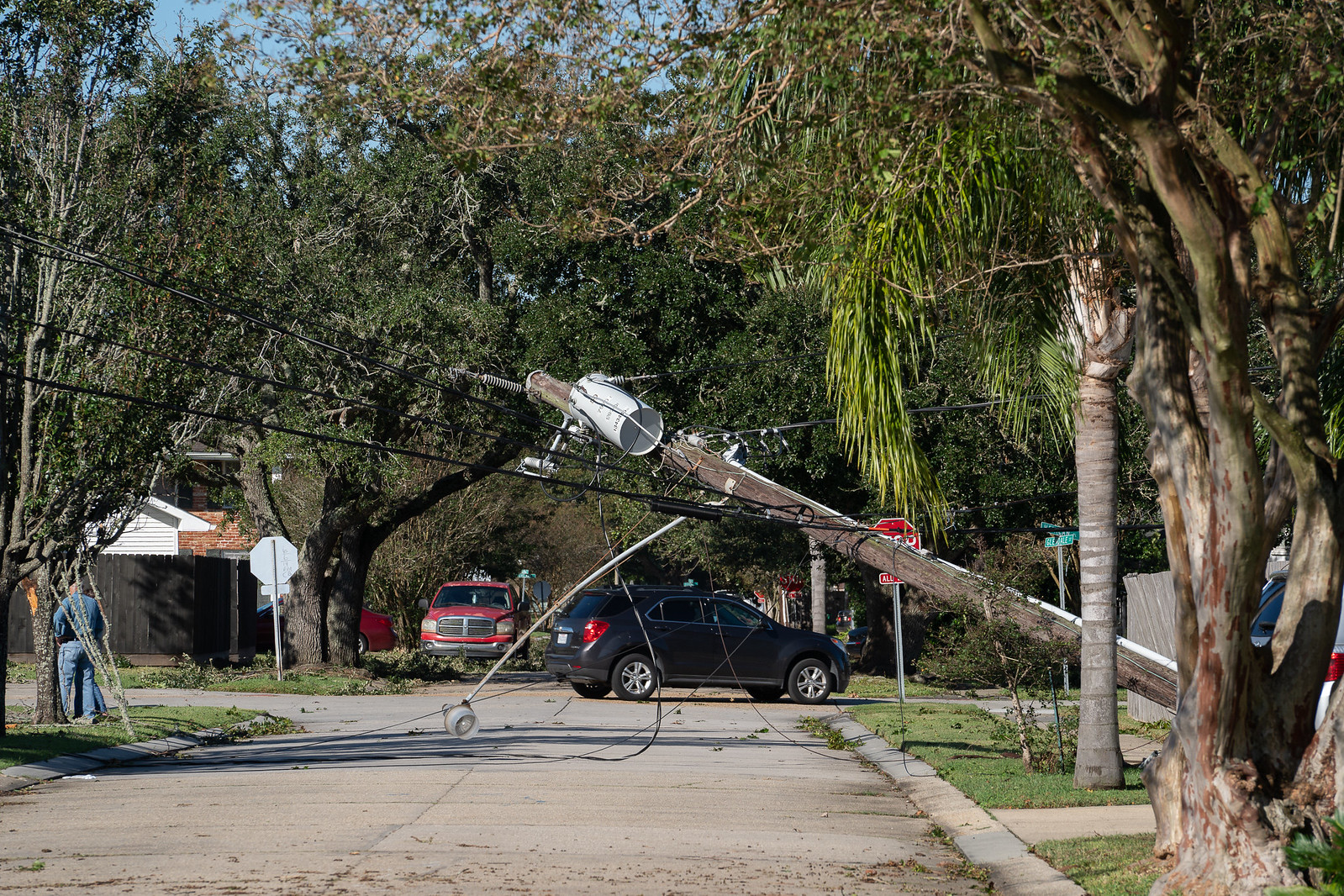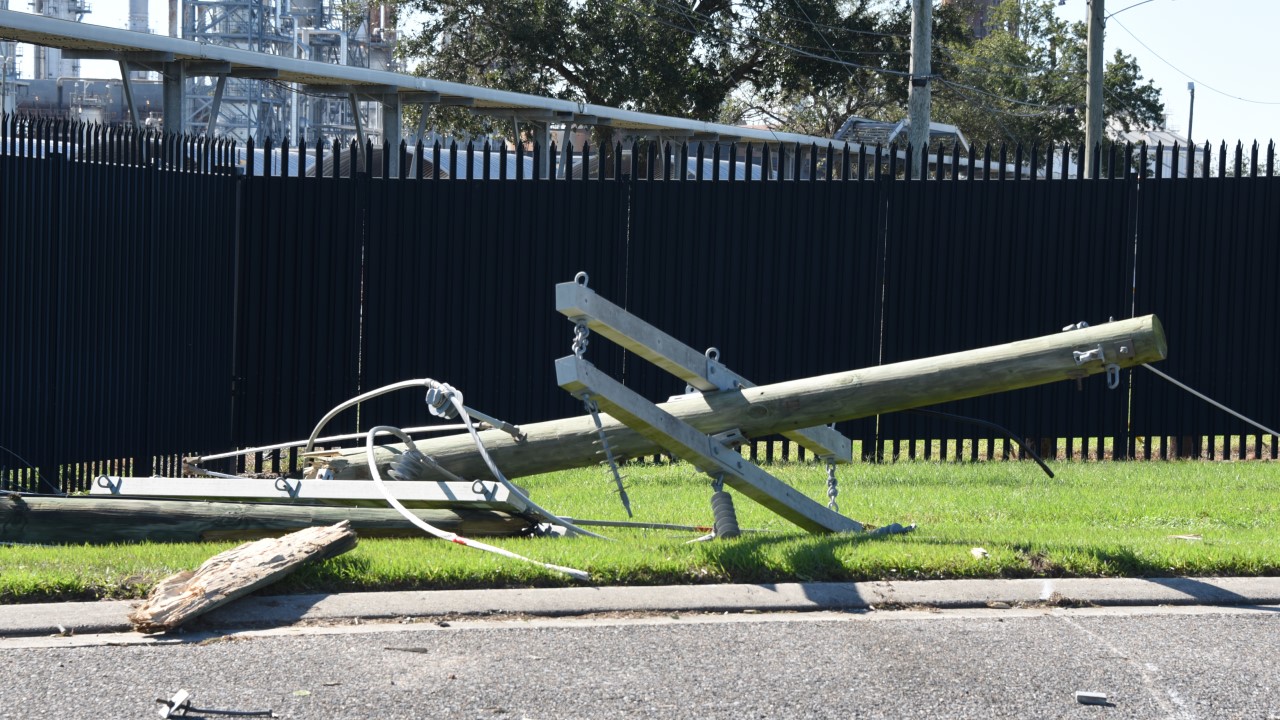Insights > Entergy System Hurricane Zeta Restoration Update – 10/29/20 @ 3 p.m.
Entergy System Hurricane Zeta Restoration Update – 10/29/20 @ 3 p.m.
10/29/2020

Click here for damage and restoration photos
Hurricane Zeta made landfall Wednesday afternoon near Cocodrie, Louisiana as a Category 2 hurricane with winds of 110 mph. The storm caused power outages for 483,000 Entergy customers in Louisiana and Mississippi.
The greatest danger during and after a storm like this is from downed power lines. If anyone sees a power line on the ground or in the trees or bushes—do not go near it! Call us at 800-9OUTAGE (1-800-968-8243).
Customers choosing to use a generator should buy one only from a reputable dealer who can service and maintain the unit. Always use portable electric generators in accordance with the manufacturer’s instructions. More generator-use information is below.
Louisiana outage information as of 1 p.m. Oct. 29:
|
|
Current Outages |
Peak Outages |
% Restored |
|
New Orleans |
130,901 |
178,171 |
27% |
|
S. Louisiana |
270,147 |
303,097 |
11% |
|
Louisiana Total |
401,048 |
481,268 |
17% |
Distribution damages to our system as of 1 p.m. include 373 poles, 77 transformers and 353 spans of wire damaged or destroyed.
On our transmission system, 14 of 30 affected substations and 14 of 37 affected transmission lines have returned to service.
The fast-moving storm has caused extensive power outages for our customers in South Louisiana, including in and around New Orleans. Jefferson and Orleans parishes are experiencing the greatest number of outages at this time.
Based on historical restoration times, customers in the direct path of a Category 2 hurricane can experience outages for up to 10 days, although 90% of customers will be restored sooner.
At Entergy, the safety of our customers and our employees guides our decision-making. We have started restoration where it is safe to do so.
- Restoration workers, who were staged near the storm impact area, are returning to damaged areas to start the restoration process as weather conditions improve.
- First, we restore power to critical community infrastructure and essential services such as hospitals, water treatment plants, police and fire stations, and communication systems.
- Then we will concentrate our resources on what gets the greatest number of customers restored the fastest.
- Please refrain from approaching utility workers at the job site because these can be dangerous locations and because interruptions will slow their progress.
We continue acquiring more resources for our restoration teams, with nearly 5,500 currently restoring service or en route for customers whose power has been affected by Zeta.
Our crews, contractors and mutual-assistance partners are prepared to work long hours, restoring service to customers as safely and as quickly as possible.
We continuously learn and improve from storm experiences, including Hurricane Laura that devastated Southwest Louisiana after making landfall Aug. 27 and Hurricane Delta on Oct. 9.
- We are ready to take appropriate action before, during and after severe weather.
- Based on previous storm responses and annual storm exercises, we are constantly updating and improving our operations related to storm damage restoration.
- Operation: Storm Ready is our internal process of continuous planning, preparation and training. And an early step, when facing a storm, is to prepare to bring in extra personnel to support the effort.
- We have worked to storm-harden our system. From aggressive preventive maintenance programs to using steel transmission structures near the coast, elevating substations that might flood and installing “isolation” devices on lines to reduce outages, our goal is always to restore power safely and quickly.
Restoration Process
Here’s how we approach things at this stage to restore your power safely and quickly:
- Essential services such as hospitals, nursing homes, fire and police departments, and water systems are at the head of the restoration list, along with our equipment that supplies electricity to large numbers of customers.
- Then we will concentrate our resources on getting the greatest number of customers back the fastest.
- We can’t use our bucket trucks until sustained winds are less than 30 mph, but we can still begin restoring service to customers by closing circuit breakers, rerouting power and other actions.
- You may see trucks, other vehicles and workers lined up while we process them into our system, taking inventory of equipment and personnel and giving a complete safety orientation.
- Repairs begin with major lines to the substations, then to the lines and equipment serving neighborhoods, businesses and homes.
- Service lines to individual homes and businesses will be restored last because fewer customers are involved, and in the case of fewer outages spread over larger areas, it often takes more time to get power back on for them.
- Road and flood-gate closures, flooding and other accessibility challenges due to the storm is affecting our ability to reach some areas of our territory and could delay restoration in those communities.
- When restoration starts, keep in mind that if you don’t see us working near you, we may be working on another part of the electrical system that you can’t see but must be repaired to get power to you.
Following a storm, we deploy scouts to assess damage. It may take up to three days before we know how long until power is restored.
As safety is always the highest of priorities, and as we assess the damage, we’ll begin restoring service where it is deemed safe to do so.
Our employees are our greatest assets; we will keep our workers safe during a storm response.
- Keeping our workers safe from worsening weather conditions may limit our ability to restore service as quickly as we’d all like.
- We are committed to keeping our employees safe and sheltered during dangerous periods caused by high winds, flooding and other severe storm conditions.
- For strong hurricanes, we evacuate from the predicted landfall area, but quickly return as soon as conditions are safe to begin restoration.
- Due to responding to a continual string of major restorations, we are placing extensive focus on guarding our employees from the dangers of fatigue. We stress with workers to treat fatigue as a work hazard.
- Our field workers work a 16-hour day that provide eight hours off to rest and restore.
- We provide our workforce with food and shelter so that they are able to focus on the task at hand.
Responding to a major storm and COVID-19 could affect our response:
- Along with standard storm preparations, Entergy employees are navigating the COVID-19 pandemic by taking additional steps. These include traveling separately when possible, adjusting crew staging locations and increasing the use of drones.
- Due to the additional measures crews must take, restoration may take longer, especially where there are widespread outages. Additionally, crews will continue to practice social distancing and we ask that customers do the same. For their safety and yours, please stay away from work zones.
Customer Safety
The safety of our workers and customers remains our key value, especially during power outages and severe weather conditions.
- The greatest danger during and after a storm like this is from downed power lines. If anyone sees a power line on the ground or in the trees or bushes—do not go near it! Call us at 800-9OUTAGE (1-800-968-8243).
- Entergy’s goal is to provide reliable electrical power at a reasonable price. But some emergency conditions may cause power outages that last for extended periods. Some customers may choose to use a portable generator during these times.
- If customers choose to use a generator, they should buy one only from a reputable dealer who can service and maintain the unit.
- Customers should always use portable electric generators in accordance with the manufacturer’s instructions.
- A gasoline engine usually powers stand-alone generators. Customers should use them only in well-ventilated areas. Never use a generator indoors as carbon monoxide from the exhaust is deadly.
- If the generator has panel-mounted electrical receptacles as part of the unit, appliances may be plugged directly into the generator.
- Customers must never connect a generator directly to a building’s wiring without a licensed electrician disconnecting the house wiring from Entergy’s service. Otherwise, it can create a safety hazard for the customer or Entergy’s linemen working to restore power. And it may damage the generator or the house wiring.
- Customers should use a licensed electrician to install the necessary equipment should they decide to wire a generator into their home wiring. The equipment should include a switch to transfer the power source between Entergy and the generator.
- The generator should be properly sized for the expected load. For example, a 3-kilowatt generator will produce 3,000 watts. This is enough power for a 1,200-watt hair dryer and a 1,600-watt toaster, with some power left over for a few light bulbs. Customers should plan for additional needs when sizing their generator.
- Customers should consider a generator’s noise pollution as part of their buying decision. The noise may be obtrusive to neighbors without power.
- Commercial customers should consult with an independent engineer or electrician to size the generator, modify wiring and provide for automatic transfer of power during an outage.
- Customers should consult with suppliers, vendors and local electrical utility companies about required permits before starting any work in a home or business.
- For our natural gas customers:
- If you smell natural gas or hear a blowing or hissing noise, open a window and leave the area immediately. Do not operate electrical switches. Call the gas company from a nearby building and don’t re-enter until it’s safe to do so. For more gas safety tips, click here.
- Stay safe. Don’t use gas or electrical appliances that have been flooded. Click here for more flood safety tips.
Stay Informed
When restoration begins, customers may experience delays when calling our telephone centers, especially from unaffected areas, due to overloading of the system with outage calls. We encourage customers to use these other means to interact with us during restoration:
- Download our free app for your smartphone at entergy.com/app.
- Sign up for text alerts by texting REG to 36778 and have your account number and ZIP code handy. The registration pattern is as follows including spaces: REG (account number) (ZIP code). Once registered, text OUT to 36778 to report an outage. You can also report an outage online as a guest.
- Visit our View Outages page.
- Follow us on Twitter.com/entergy or Facebook.com/entergy.
- Call us at 1-800-9OUTAGE (1-800-968-8243).
- Follow updates in your local news media, like radio, television and newspapers.
We caution customers to be aware of unscrupulous attempts to swindle our customers during Hurricane Zeta recovery.
- Entergy never demands immediate payment from customers over the phone. You shouldn't give your personal information to strangers.
- If a call sounds suspicious, hang-up and call 1-800-ENTERGY (1-800-368-3749) to speak directly with an Entergy customer service representative.
- If you believe you are a victim of this scam, notify the proper authorities, such as the local police or the state attorney general's office.

